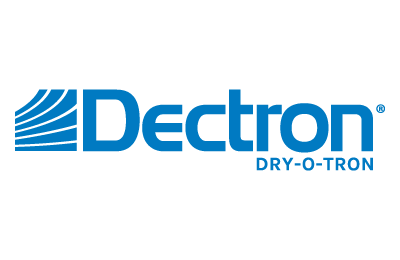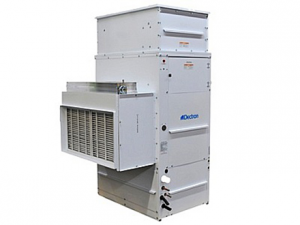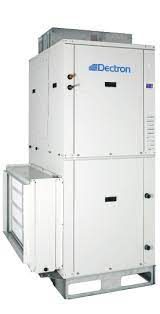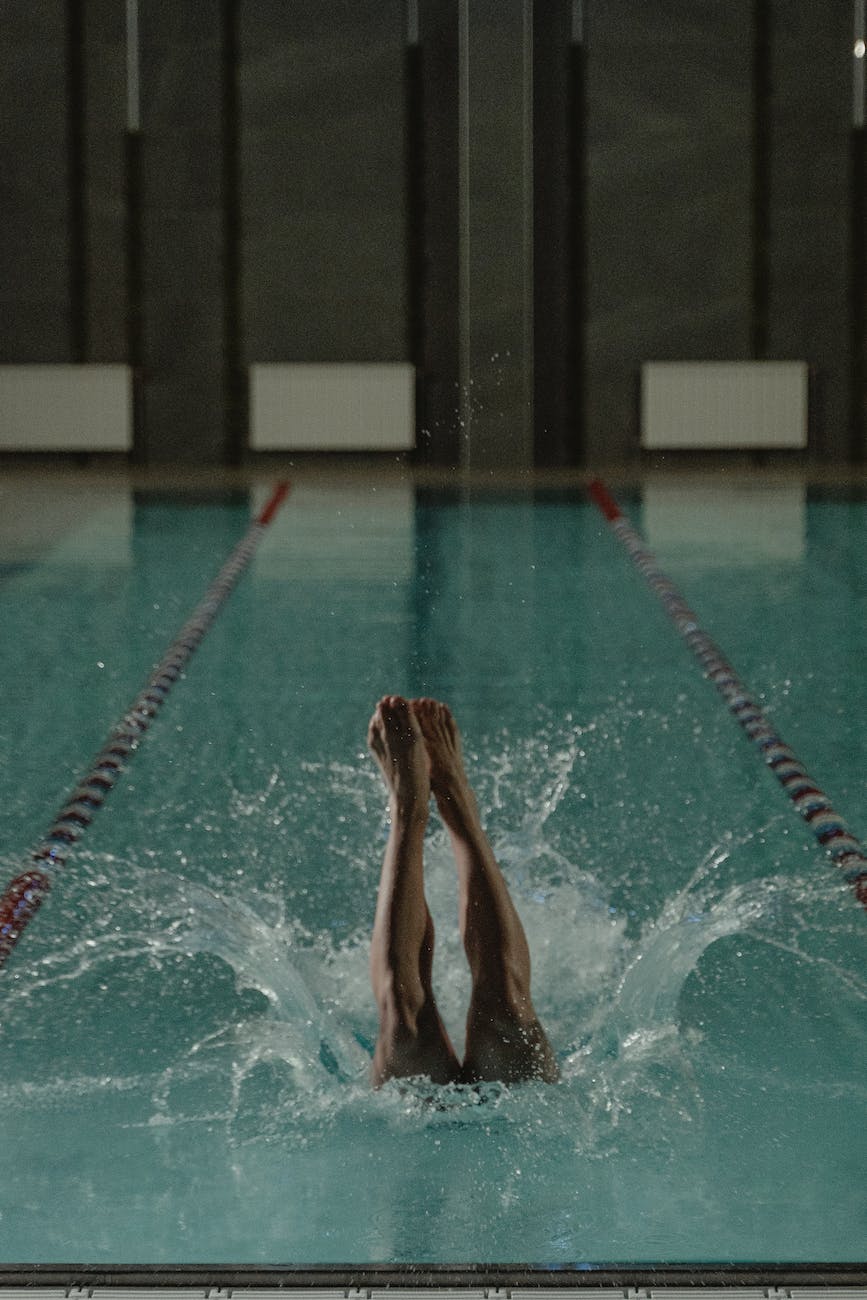Indoor Pool Humidity Control
Most people associate the interior of indoor pools with high humidity, stuffy air and steamy windows and walls. Water condensation is not only an aesthetic, comfort and health problem but will in the long term, cause structural damage to the building. These conditions can be corrected using a Dry-o-tron dehumidification system that utilizes energy saving features.
The air quality of pool enclosures is gauged by several key factors, with the most common being relative humidity (measured as the percentage of moisture in the air). Relative humidity levels in a pool room are clearly higher than normal as water evaporates from the surface of the pool. In addition, moisture can be drawn into the room from outdoor make-up air and from pool users or spectators. With the use a dryotron and outdoor condenser, fresh air from outdoors can be conditioned to reach both humidity and temperature optimal set points.
The vapor pressure differences between pool water and air cause continuous evaporation producing high humidity conditions in the pool room. The evaporation rate is a function of activity in the pool. If water is calm, there is a known evaporation rate. However, if people are swimming or playing in the pool, the surface area increases (the waves will have the tendency to double the actual pool surface area) which will increase the effective evaporation rate by a similar factor. Larger commercial pools must take this factor into consideration.
During summer months, outside air that enters the pool room through make-up air handling systems can increase the moisture content of the indoor air because it has relative humidity that is equal to or higher than the pool room. This compounds the indoor humidity problem. Utilizing a hrv in combination with a dryotron offers optimal efficiency without compromising target set points.
People in the pool room will add to the moisture content. This is negligible in residential pools, but can be significant in pool facilities with spectator seating.
Problems With Humidity
Air is a gas and, like most gasses, expands and contracts in volume when heated or cooled. This expansion or contraction with changing temperature increases and decreases the percentage of humidity that the air can hold. As it is heated, air expands and its ability to hold moisture increases.
Condensation will form on glass surfaces whenever the temperature of the glass is below the dew point of the air.
High humidity in a pool facility can cause rapid structural deterioration and corrosion problems. It is important to select the proper dehumidification system that will give you worry free operation and maximum efficiency. During winter months or cool summer evenings, outdoor temperatures may be significantly below that of the indoor air. Warm air retains the moisture, but cooler walls or window surfaces will cause moisture to condense.
Damage to the structure occurs when relative humidity levels reach 62% or above for an extended period. Chlorine from pool chemicals is carried along in the evaporation process. The chlorine reacts with the condensed water to form hydrochloric acid (HCl) which will accelerate the effects on wood and metal surfaces.
High humidity can also affect the air quality by providing an excellent environment for bacteria, fungi and viruses to grow and multiply. By keeping the humidity in the range of 40-60%, there will be a reduction in the number and activity of these organisms. Finally, high humidity is uncomfortable for those using the pool room.
Elimination of Humidity
There are several techniques for eliminating the humidity in the pool room. The most used technique (warm climates) of reducing humidity is the Make-up Exhaust method. With this technique, the warm moist air is exhausted to the outdoors while outside air (which normally has a lower moisture content) is brought in as make-up. When this air is heated the effective relative humidity of the outside air is reduced. There are two problems associated with this method. First the energy is lost when the warm indoor air is discharged outside. Second, during the summer months the outside air may have a higher humidity than the indoor air, thus actually increasing indoor humidity.
The heat stored in the air of a pool enclosure comprises two parts- sensible and latent heat.
When pool water evaporates, significant energy is utilized and is known as latent heat. Latent heat is in effect stored by water vapor in the air and is directly related to the relative humidity level. This energy is replaced through the pool water heater.
Heat stored in the air is called sensible heat, so called as it can be measured or sensed with a thermometer. This sensible heat lost would be evident in the energy consumed for the heating of the make-up air. A method of addressing the lost sensible heat is to add a heat recovery unit to the exhaust system. This technique takes the sensible heat from the exiting air and exchanges it to the incoming air. This partially reduces the energy loss however, the largest energy loss comes from the energy required to heat the pool water.
The need for summer time cooling may be approached by the use of an air conditioner and this works to remove the sensible heat. The air conditioner must also use energy to remove the latent heat, a job for which an air conditioner is not well suited.
The operating costs of the air conditioner increase significantly when outdoor air ventilation is increased in a humid climate, since overcooling is often the only means of removing sufficient moisture.
A key advantage of the dehumidifier system (dryotron) over the air conditioning approach is the dehumidifier’s ability to recover all of the heat (sensible and latent).
The warm moist air is condensed and cooled at a dehumidifier coil thus transferring all of the energy to a refrigerant. The recovered energy can be given back to the air stream at the reheat coil in the form of sensible heat thus recovering almost 100% of the energy. This heat is returned to the pool room environment maintaining the appropriate air temperature. Additional heating is only required to compensate for heat loss through the windows and walls. Dehumidifier designs also offer alternate heat sinks such as a water cooled heat exchanger to heat the pool water in addition to the air. A third alternative is a remote condenser which transfers the heat outdoors to provide summer time cooling in the pool enclosure.
Calculation of Moisture Load for Dehumidification
The calculation of moisture load is central to dehumidifier selection. Typically, design conditions will assume that the air temperature is kept at around 1°C higher than the water to hold evaporation to a minimum.
The calculation of evaporation rate takes into account various factors, including pool water temperature, air temperature, humidity level, water agitation, wet surfaces and air flow rates.
The difference between still and active water is very important in determining the evaporation rate. For example, a popular public pool may have twice the evaporation rate of a private pool. In the calculation of moisture load, this is addressed by the use of an activity factor.
The make-up air load requirements for commercial operations will vary depending on local state regulations. It should be noted that some or all of the outside air brought into the enclosure as make-up may be directed through other air handling equipment which would reduce its moisture load. The final make-up air volume will need to be adjusted for a specific moisture content based on the geographic region in which the pool is located.
Commercial pools may have a spectator seating area. The human body itself produces water through the pores of the skin. The more active you are, the more water vapour produced.
Air Distribution
The design of the air distribution system is critical and impacts on the evaporation rate, bather comfort, condensation level and air quality.
The air velocity near the pool surface needs to be kept low as high velocities can double the evaporation rate, greatly reducing humidity control efficiency and increasing energy consumption. Lower air velocity at this point also increases the comfort level of pool users.
The flow of air from the dehumidifier (supply air) is used to protect areas of likely condensation build-up. Supply air is directed to areas of low R-Value, placing a layer of warm dry air to blanket the vulnerable surface such as exterior glass.
Glass on exterior walls will readily form condensation, particularly when outdoor air temperatures are low. This occurs as the glass reflects the outside temperature more so than any other inside surface. The design of the building and selection of glazing and sash material are important aspects. The use of double glazed glass is recommended, although it is noted that even triple glazed glass can have an inside temperature below the point at which condensation will occur (ie. the glass reflects a temperature below the dew point). Sophisticated building design will include vapour retardant in wall construction.
The optimal result for condensation control is to keep all glass surfaces around 2°C to 3°C above the pool room dew point. This means that supply air is directed to the glass surfaces by linear diffusers and consequently, the design and placement of the air distribution registers and diffusers is critical.
Underfloor air distribution is advantageous to cover low external windows or any glass doors.
For high windows placed high in the building, the supply air must be directed at the glass from close proximity and the air quantity and velocity must be sufficient to blanket the entire area with warm dry air. Skylights are prone to condensation build-up and are not recommended. If these are evident in the building design, these would best be protected by perimeter air distribution mounted at high level.
The air system design must also allow for the removal of the total volume of air and the number of air changes will be mandated by ventilation codes for commercial pools. The optimal figure would be between four to eight air changes per hour and this prevents air stratification and stagnation.
Overall
Commercial pool enclosures must account for all three factors: evaporation, make-up air and people. It is important to note that the sizing calculations being used averages the moisture load over 24 hours. This means that the dehumidifier will utilise the inactive times to catch up on moisture removal. Generally the dehumidifier will be able to maintain a 65% RH value during active periods, and a 55% RH during inactive. Residential pools do not have the make-up air loads nor the people loads, thus their moisture calculations are reduced to evaporation content only






